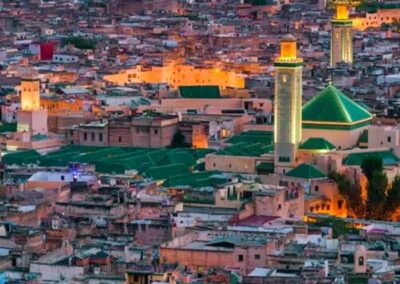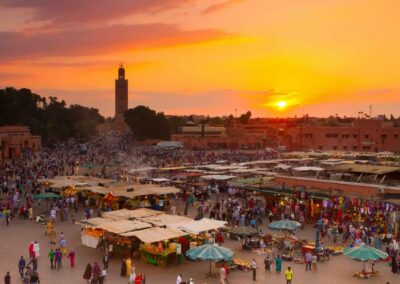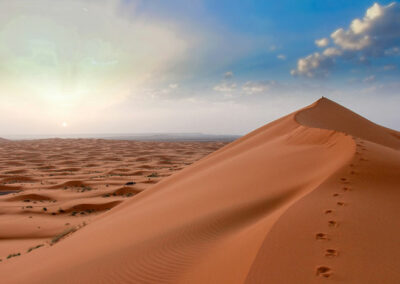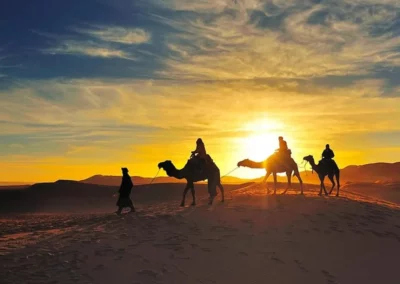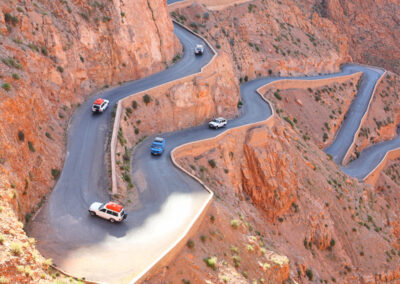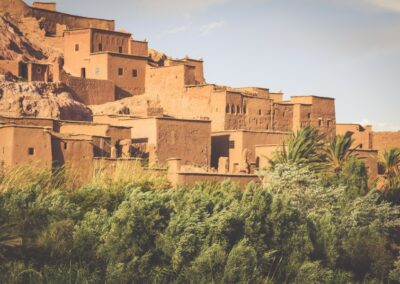
7 Days Desert Tour from Marrakech to Imperial Cities
7 Days Desert Tour from Marrakech OVERVIEW :
7 Days Desert Tour from Marrakech, highlights :
- Marrakech Medina: Wander through the historic souks and the lively Jmaa el Fna Square.
- Tizi n’Tichka Pass: Drive through the High Atlas Mountains, enjoying breathtaking views of Berber villages.
- Ait Benhaddou Kasbah: Visit the famous UNESCO World Heritage site, a backdrop for many films.
- Dades Gorges: Explore the scenic “Road of a Thousand Kasbahs” and the dramatic canyon landscapes.
- Todra Gorges: Stroll through towering cliffs and experience the beauty of the desert.
- Merzouga Desert: Camel trek into the Erg Chebbi dunes, enjoy a stunning sunset, and spend a night in a nomadic bivouac.
- Gnawa Music in Khamlia: Enjoy traditional music and dance by the Berber people of Mali origin.
- Rissani Souks: Discover authentic, traditional souks known for crafts, food, and animal trade.
- Ziz Valley: Drive through lush oasis landscapes with thousands of palm trees and panoramic views.
- Fez Medina: Explore the cultural heart of Morocco, visiting the famous tanneries and winding streets filled with history.
7 Days Desert Tour from Marrakech Itinerary
Day 2 : Marrakech – Tizi n’Tichka – Dades Gorges
After breakfast, we will address Marrakesh Dades Gorges. On the way we cross the High Atlas Mountains, crossing the Tizi n’Tichka, threading our way among many peoples of nomadic Berbers who inhabit the area. Spectacular scenery will take us to the Kasbah of Ait Benhaddou, famous as the scene of more than two dozen films, including “Babel”.Continue to Ouarzazate via the Valley of Roses crossing, to get into the Dades Gorges, where begins the “road of the thousand kasbahs”. Dades Valley Accommodation and dinner at the hotel.
Day 3 : Dades Gorge – Todra Gorges – Merzouga Sahara
Breakfast at the hotel. We headed to the Todra Gorge, where you can take a leisurely stroll through its imposing canyon walls over 200 meters high, to exit into the desert through the palm of Tafilalet. Arrive at the hotel on the foot of the dunes, where you can walk the fine sand of the Erg Chebbi, relax, and enjoy the stunning scenery. At night, will savor a delicious Moroccan dish. Overnight in a hotel room.
included :
- Transport in 4×4 car with Air condition
- Private driver/English speaking guide
- Accommodation (dinner and breakfast) in hotels
- Camel ride through the desert
- Sleep in desert tent
excluded :
- Airline tickets
- Noon meals
- Drinks
- Entrance fees
More information about the Places you will visit in this 7 Days Desert Tour from Marrakech
Marrakech – The Beating Heart of Morocco
Overview
Marrakech, known as the “Red City,” is one of Morocco’s four imperial cities and a cultural capital steeped in history, art, and architecture.
What Makes It Famous
Its UNESCO-listed Medina, the world-famous Jemaa el-Fna Square, and the vibrant souks make Marrakech one of the most visited cities in Africa.
Historical and Cultural Significance
Founded in 1062 by the Almoravid dynasty, Marrakech became a powerful imperial center. Its architecture blends Arab, Berber, and Andalusian influences, and its palaces, mosques, and gardens are reminders of its rich past.
Highlights and Unique Features
-
Jemaa el-Fna: a lively square with snake charmers, storytellers, and street food
-
Koutoubia Mosque: Marrakech’s iconic minaret
-
Bahia Palace and Saadian Tombs: masterpieces of Islamic architecture
-
Majorelle Garden: a colorful retreat once owned by Yves Saint Laurent
Traveler Experience
Expect sensory overload: aromatic spices, vibrant textiles, and the sound of drums and flutes echoing through the streets. Don’t miss a sunset tea on a rooftop café overlooking the square.
Local Life
Marrakech’s residents are proud of their traditions. The city pulses with energy, especially at night when the square transforms into a festival of lights, music, and flavors.
Tizi n’Tichka Pass – A Journey Through the High Atlas
Overview
The Tizi n’Tichka Pass is a dramatic mountain road that connects Marrakech with the desert regions beyond the High Atlas Mountains.
What Makes It Famous
At 2,260 meters above sea level, it is the highest major mountain pass in North Africa and offers stunning panoramic views.
Historical and Cultural Significance
Historically, this route was used by Berber caravans transporting salt, spices, and goods between sub-Saharan Africa and the Mediterranean world.
Highlights and Unique Features
-
Panoramic views of snow-capped peaks and lush valleys
-
Berber villages clinging to the mountainsides
-
Opportunity to spot traditional flat-roofed houses and terraced fields
Traveler Experience
It’s a thrilling drive full of switchbacks and stunning photo stops. In spring, you’ll see the peaks dusted with snow while wildflowers bloom below.
Local Life
You may spot shepherds and locals tending flocks or selling argan oil and handmade crafts along the roadside.
Ait Ben Haddou – Morocco’s Most Photographed Fortress
Overview
Ait Ben Haddou is a fortified village (ksar) located near Ouarzazate and one of Morocco’s best-preserved examples of traditional earthen architecture.
What Makes It Famous
It’s a UNESCO World Heritage Site and a favorite Hollywood filming location, featured in Gladiator, Game of Thrones, Babel, and more.
Historical and Cultural Significance
Ait Ben Haddou was once a thriving trading post on the trans-Saharan caravan route. Its layered homes, towers, and granaries show how Berber families once lived and defended their settlement.
Highlights and Unique Features
-
Clay walls, narrow alleys, and watchtowers rising above the river
-
The climb to the granary provides sweeping views of the Ounila Valley
-
The contrast between ancient architecture and modern life across the river
Traveler Experience
Walking through Ait Ben Haddou feels like entering a historical movie set. Local guides can explain its history and show you where famous scenes were shot.
Local Life
A few families still live inside the ksar, preserving its legacy. Others operate small shops selling Berber rugs, pottery, and fossils.
Ouarzazate – Gateway to the Sahara and Cinema City
Overview
Ouarzazate is a desert town known for its film studios and stunning kasbahs. It’s often the last major stop before reaching the Sahara.
What Makes It Famous
Nicknamed “The Hollywood of Africa,” it’s home to Atlas Studios, one of the largest film studios in the world.
Historical and Cultural Significance
It developed under French colonial influence and has become a cultural hub for southern Morocco. The Taourirt Kasbah was once the residence of the powerful Glaoui family.
Highlights and Unique Features
-
Atlas Film Studios: open for tours with sets from famous movies
-
Taourirt Kasbah: a maze of rooms and passageways with beautiful architecture
-
Proximity to oases and valleys like Fint Oasis
Traveler Experience
Film lovers will enjoy walking through replica temples and desert sets. The surrounding arid landscape adds a surreal touch to the experience.
Local Life
Ouarzazate has a calm, laid-back feel with friendly locals, colorful markets, and a unique blend of Berber and Saharan culture.
Dades Gorges – The Valley of a Thousand Kasbahs
Overview
The Dades Gorges are a series of dramatic sandstone canyons carved by the Dades River, located between the High Atlas and Jbel Saghro ranges.
What Makes It Famous
This area is known for its unique rock formations, including the “Monkey Fingers,” and its winding road of hairpin turns — a dream for photographers.
Historical and Cultural Significance
For centuries, Berber tribes have lived in this valley, building fortified homes (kasbahs) and cultivating lush oases from the river.
Highlights and Unique Features
-
The “Monkey Fingers” rocks and the serpent-like mountain road
-
Colorful kasbahs set against the red cliffs
-
Almond blossoms in spring and changing colors in autumn
Traveler Experience
You’ll pass picturesque villages, orchards, and date palms. A short hike or a tea break in a local guesthouse reveals the peaceful rhythm of valley life.
Local Life
Residents live simply, farming and raising livestock. Hospitality is a core value — expect warm welcomes from locals.

